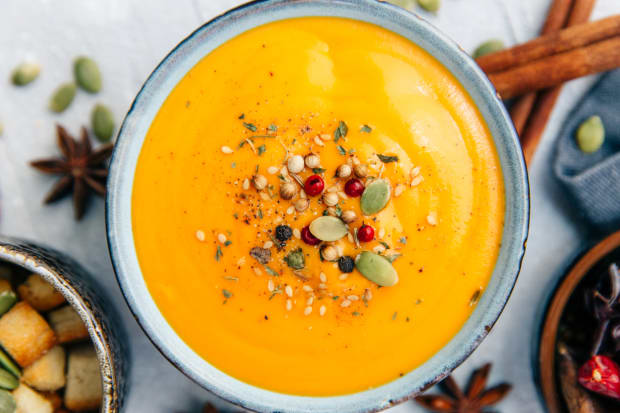[adinserter block=”2″]
Heirloom pumpkins look oh so pretty gracing a decorated Thanksgiving table, cozy front porch, and sprinkled throughout the home for a touch of autumn flair and color.
But when it’s time to deck the halls with boughs of holly, don’t throw away those gorgeous pumpkin decorations. Eating heirloom pumpkins is a delicious, and resourceful way to use up these pretty pumpkins instead.
Types of Heirloom Pumpkins
Heirloom, or specialty, pumpkins come in all shapes, sizes, and colors. From orange and green striped Kakai pumpkin, to brilliant blue Jerrahdale pumpkins, white moonshine pumpkins, French Musque de Provence pumpkins, and everything in between.
Heirloom pumpkins store very (very!) well, with some boasting storage life of up to six months. Stash pumpkins in a cold, dark space to use in recipes throughout the winter.
Unlike bland-tasting Halloween pumpkins, which are best suited for carving faces, heirloom pumpkins possess flavor and texture unlike any other squash out there.
“The biggest differences between heirloom pumpkins and grocery store varieties are their thicker walls, which yield more flesh for cooking, and their sweeter taste, which is why varieties like Sugar Pie are popular for, well, pies,” notes Grant Butler, writer at The Oregonian.
iStock/victoriabee
Eating Heirloom Pumpkins
Pumpkins are more than just pie, of course.
Pumpkins are grown around the world and used as culinary staples in Indian, Thai, Mexican, and Scandinavian cuisines, among others. Eating heirloom pumpkins are amazing pureed, cut into pieces, grilled, fried, and so much more.
Like winter squash, heirloom pumpkins require a decent amount of time to cook, and a sharp knife to process before enjoying their unique flavor. Use a sharp knife to carefully cut pumpkin in half or pieces. If cutting is not an option (if the pumpkin too large or hardy), hold it firmly and smash against a hard surface, like concrete or bricks.
Here’s How to Cook Your Pumpkins

iStock/studiobarcelona
Scoop out the pumpkin seeds and set aside if roasting.
To cook heirloom pumpkin, preheat the oven to 400 degrees Fahrenheit and line a baking tray with parchment paper.
Place pumpkin cut side down on parchment paper tray and roast for 30-60 minutes, depending on the variety and how big it is.
When a fork can easily pierce the pumpkin, it’s done.
Carefully peel skin from pumpkin flesh and discard. These pieces of cooked pumpkin can be added to hearty winter grain salads, tacos, or eaten as a side dish with salt, pepper, and olive oil.
Heirloom pumpkins puree perfectly for sweet recipes (like pie), creamy soups, and even smoothies. Here’s a list of recipes to use pumpkin puree:
- Pumpkin Spiced Latte
- No-Bake Pumpkin Balls
- Homemade pumpkin pie spice
- Pumpkin Chia Seed Pudding Recipe
- Pumpkin Muffin Recipe – It’s Gluten Free and Vegan
- Homemade Pumpkin Pie from Scratch!
- Pumpkin Oatmeal Recipe
- Spicy Roasted Pumpkin Soup Recipe with Leek
- Pumpkin Fettuccini Alfredo Pasta with Greens [Dairy-Free]
To make pumpkin puree, scoop out cooked pumpkin flesh from skin and add to a food processor or high-speed blender. Process until pumpkin is completely smooth and creamy. Pumpkin puree can be frozen and stored for one year.
Alternatively, raw cut pumpkin can be added to soups, stews, and curries to be cooked in the process. This is a delicious way to add flavor and texture to delicious recipes.
The Health Benefits of Pumpkins are Plenty
The perks of eating pumpkin? Plenty of fiber, vitamins A and C, antioxidants, iron, potassium, copper, and protein in a delicious, seasonal and versatile fruit.
Related On Organic Authority
8 Non-Toxic Cookware Brands to Keep Chemicals Out of Your Food
Paleo Pumpkin Pie from Scratch: The Most Delicious Pumpkin DIY Ever
How to Use the Whole Pumpkin! From Skin to Seeds
[adinserter block=”2″]
Source link

